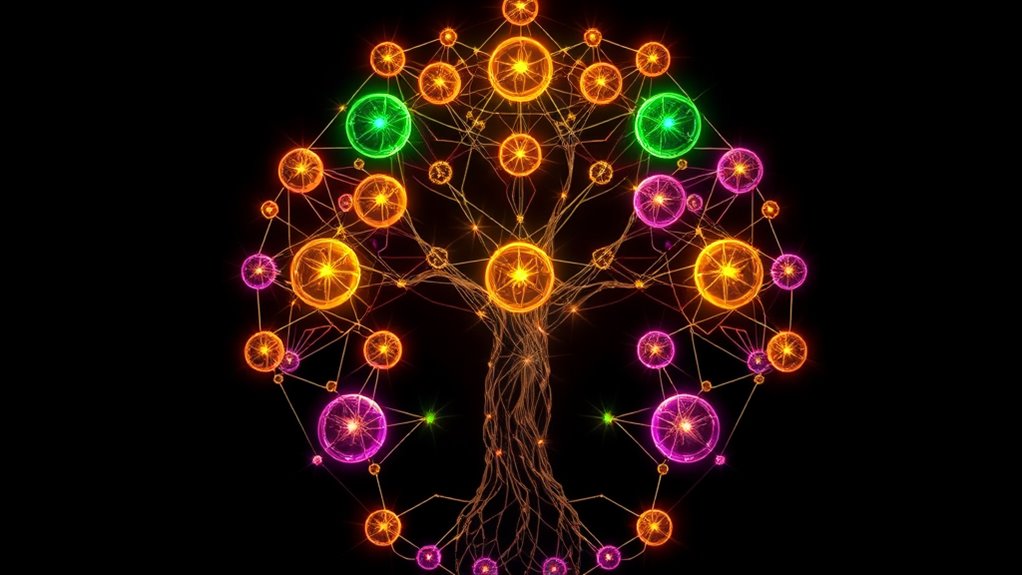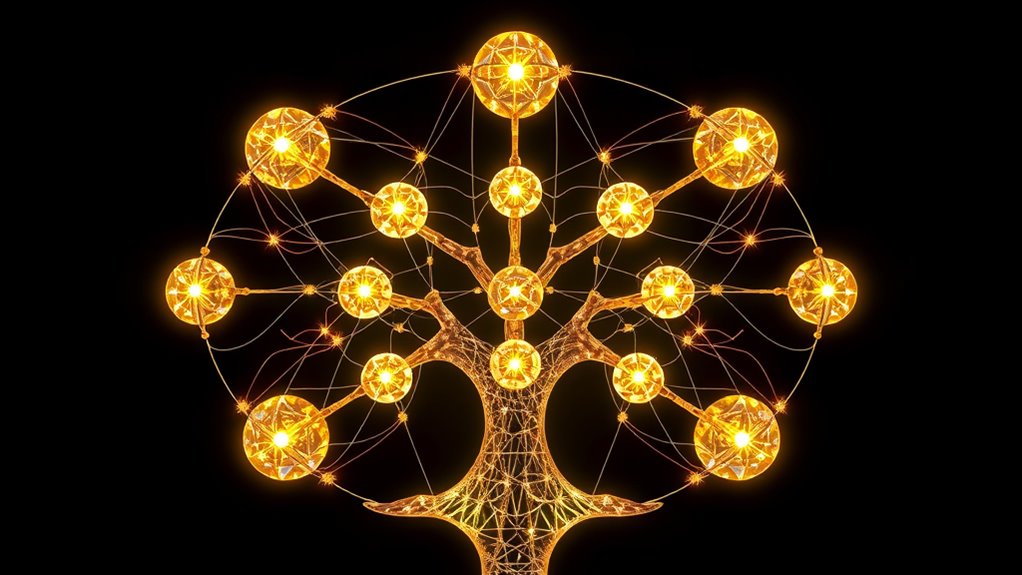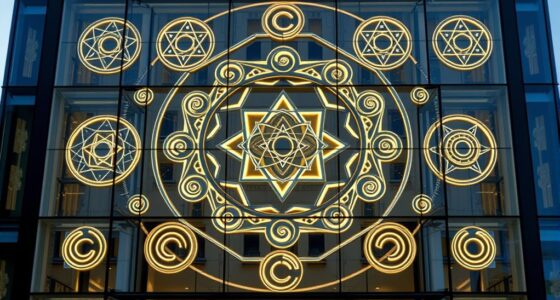The Qabbalistic Tree of Life features ten spheres, known as Sephiroth, interconnected by 22 paths that form a precise geometric pattern. As you explore, you’ll visualize these spheres as luminous centers of divine qualities and trace the paths to see how energy flows through the universe’s structure. Understanding their symbolic meanings and geometric relationships helps deepen your spiritual insight. Keep exploring, and you’ll uncover the profound harmony behind this ancient sacred map.
Key Takeaways
- The Tree of Life features ten Sephiroth (spheres) interconnected by 22 distinct paths, forming a complex geometric network.
- These paths follow specific geometrical patterns that symbolize divine energy flow and spiritual connections.
- The arrangement of ten spheres and 22 paths creates a sacred geometric blueprint representing universal structure.
- Visualizing the spheres and paths geometrically enhances understanding of divine attributes and spiritual progression.
- The pattern of ten Sephiroth and 22 paths reflects the dynamic, interconnected architecture of the divine cosmos.

Have you ever wondered how the ancient Qabbalists visualized the universe’s structure? They used a powerful tool called the Tree of Life, a symbolic map that reveals the interconnectedness of all things. At its core, this structure combines spheres—called Sephiroth—and the paths that connect them. To truly grasp its depth, you can engage in meditative visualization, imagining yourself moving through the spheres, each representing different divine attributes or spiritual states. This practice helps you internalize the symbolic correspondences embedded within the Tree, transforming abstract concepts into lived experience.
As you begin your meditation, picture the spheres as luminous orbs arranged in a specific pattern. Each Sephirah embodies unique qualities—wisdom, understanding, mercy, severity—and each has its own symbolic meaning. Visualizing these spheres isn’t just a mental exercise; it’s a way to connect consciously with the divine energies they represent. The paths that link these spheres form a network of channels, guiding spiritual energy and consciousness from one state to another. These paths aren’t random; they follow precise geometrical patterns that hold deep significance, illustrating how different aspects of the divine interact and influence each other. Recognizing the geometric patterns within the Tree can deepen your understanding of its structure and purpose.
Understanding the symbolic correspondences of the Tree’s elements allows you to interpret your meditative visualization more meaningfully. For example, moving from the sphere of Chesed (mercy) to Geburah (severity) symbolizes balancing compassion with discipline. These symbolic meanings help you navigate your inner spiritual journey, providing clarity during contemplation. As you visualize the paths, you can imagine yourself journeying along them, witnessing the flow of divine energy and insight. This process deepens your awareness of the interconnectedness described by the Tree, emphasizing that each sphere and path plays a essential role in the cosmic blueprint.
The geometry of the Tree of Life isn’t just a static diagram; it’s a dynamic framework that reflects the universe’s structure. By practicing meditative visualization, you turn this geometry into a living map—one that guides your spiritual growth. The interplay of spheres and paths shows how different divine aspects interplay, forming a harmonious whole. As you explore these correspondences, you develop a more intuitive understanding of the universe’s divine architecture, making the abstract tangible. Ultimately, this practice helps you realize that the Tree isn’t just a symbol but a spiritual map you can traverse, revealing the divine order underlying all existence.
Frequently Asked Questions
How Does the Tree of Life Relate to Other Mystical Systems?
You see the Tree of Life as a map of spiritual hierarchies that connect different mystical systems. Its spheres often align with numerical correspondences found in other traditions, like chakras or planetary energies. Paths represent spiritual journeys, echoing concepts of ascent and enlightenment. By understanding these connections, you can see how various mystical systems share common structures, helping you deepen your spiritual insight and integrate diverse esoteric knowledge.
Can the Tree of Life Be Applied in Modern Science?
You might wonder if the Tree of Life can fit into modern science. While traditionally mystical, some see its structure as a blueprint for understanding complex systems, sparking intriguing scientific correlations. Its symbolic applications inspire new ways to visualize interconnectedness in fields like quantum physics and biology. Though not proven scientifically, the Tree’s patterns challenge you to explore deeper connections between ancient wisdom and contemporary discoveries.
What Are Common Misconceptions About the Tree’S Geometry?
You might think the tree’s geometry is straightforward, but misconceptions often lead to misinterpretation and oversimplification. Many believe it’s just a simple diagram, but it’s actually a complex system with intricate connections. Some see it as purely symbolic, ignoring its geometric depth. Don’t fall for the geometric misrepresentation that reduces it to basic shapes—understand that its true structure reflects a deeper, layered meaning beyond surface appearances.
How Do Different Cultures Interpret the Tree’S Symbolism?
Imagine exploring a universal symbol that whispers different meanings across cultures. You’ll find that many see it as a map of spiritual growth, guiding souls through transformation. In Eastern traditions, it symbolizes harmony and balance, while in Western mysticism, it represents divine connection. These cultural symbolism and spiritual interpretations shape how each society views the tree, making it a rich tapestry of shared human understanding that transcends borders.
Is There a Practical Way to Meditate Using the Tree’S Structure?
You can use meditative visualization to connect with the tree’s structure by imagining yourself moving along its energetic pathways. Focus on each sphere as a point of energy and visualize flowing between them, aligning your breath with these pathways. This practice helps strengthen your awareness of your inner energy and promotes balance, making your meditation more profound and insightful as you navigate the tree’s interconnected system.
Conclusion
As you explore the Qabbalistic Tree of Life, you see the interconnectedness of the ten spheres and the 22 paths, revealing the unity within complexity. You recognize that each sphere and path reflects a facet of your spiritual journey, a mirror of divine harmony and personal growth. Embrace the intricate design, understand its symbolism, and let it guide you through discovery, transformation, and enlightenment—because in this study, every connection deepens your understanding and elevates your awareness.











